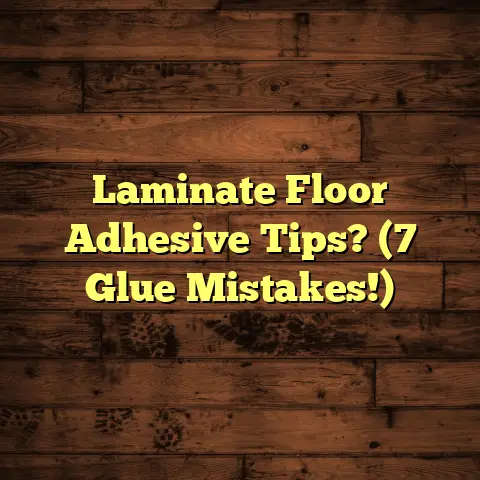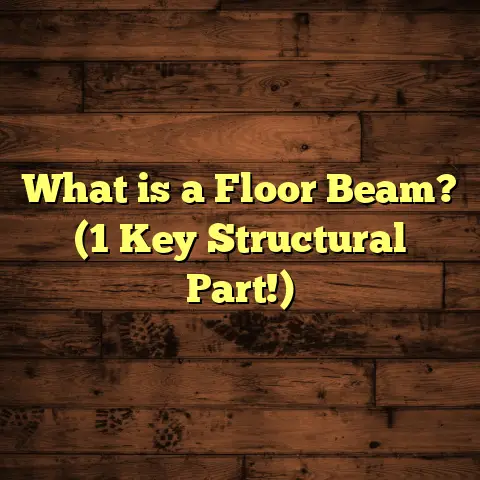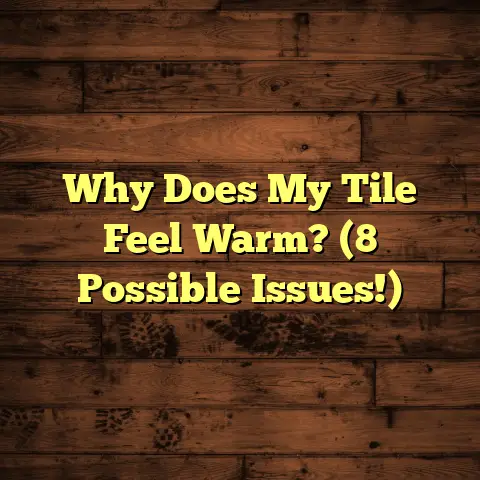Fill Void Under Wood? (3 Risks of DIY!)
From squeaks that drive you crazy to dips that feel like walking on the moon, voids under wood floors are a common headache.
The good news?
The flooring industry has exploded with innovation!
We’re talking about advanced wood treatments, super-smart subfloor materials, and filling compounds that are practically magic.
These advancements have made tackling flooring repairs yourself more appealing than ever.
DIY is in the air, and I get it.
Who doesn’t love saving some cash and feeling that sweet satisfaction of a job well done?
But here’s the thing: while DIY projects can be awesome, they can also turn into a nightmare, especially when you’re dealing with voids under your beautiful wood floors.
Trust me, I’ve seen it happen.
That’s why I’m here to shed some light on the potential pitfalls of DIY void filling and why sometimes, calling in a pro is the smartest move you can make.
Understanding the Problem of Voids Under Wood
So, what exactly are we talking about when we say “voids”?
Simply put, voids are empty spaces that develop between your wood flooring and the subfloor beneath it.
Think of it like this: your floor is a team, and the subfloor is the foundation.
When that foundation isn’t solid, you get gaps – the dreaded voids.
What Causes These Pesky Voids?
Voids don’t just appear out of thin air. There are a few common culprits:
Settling of the House: Over time, houses settle.
It’s a natural process, but it can cause shifts in the foundation and subfloor, leading to voids.Moisture Damage: Wood and water are not friends.
Excess moisture can warp the subfloor, creating gaps.
Leaks, humidity, even spills can contribute.Poor Installation Practices: This is a big one.
If the original flooring wasn’t installed properly, with adequate support and proper fastening, voids are almost inevitable.
Structural Implications: Why You Should Care
Why should you even care about a few empty spaces under your floor?
Well, voids can cause a whole host of problems:
Squeaking: That annoying squeak every time you walk across the floor?
That’s likely a void.
The wood rubs against the subfloor (or lack thereof), creating that telltale sound.Warping: Without proper support, wood planks can start to warp and bend over time.
This not only looks bad but can also create trip hazards.Potential Collapse: In severe cases, large voids can weaken the entire floor structure.
This is rare, but it’s a serious safety concern.
To give you a better visual, here are some common types of flooring and how voids might develop:
Hardwood Floors: Solid hardwood is particularly susceptible to moisture issues.
If the subfloor isn’t properly sealed or if there’s a leak, the wood can expand and contract, leading to voids.-
Engineered Wood Floors: While more stable than solid hardwood, engineered wood can still develop voids if the subfloor is uneven or improperly installed.
Laminate Floors: Laminate is often installed as a floating floor, meaning it’s not directly attached to the subfloor.
Voids here can cause excessive movement and damage to the interlocking system.
The Allure of DIY Solutions
Okay, so you’ve got voids.
Now what?
For many homeowners, the first thought is: “I can fix this myself!” And I get it.
The DIY bug is strong, and there are some compelling reasons to go that route:
Cost Savings: Let’s face it, hiring a professional can be expensive.
DIY promises to save you money on labor costs.Convenience: No need to schedule appointments or wait for a contractor to show up.
You can tackle the project on your own time.Satisfaction: There’s a real sense of accomplishment that comes with fixing something yourself.
It’s empowering!
DIY Materials and Techniques: A World of Options
The DIY market is flooded with products designed to fill voids.
Here are a few popular choices:
Foam Fillers: These come in spray cans and expand to fill the void.
They’re relatively easy to use but can be messy.Spray Insulation: Similar to foam fillers, but designed for insulation.
Can be used to fill larger voids.Self-Leveling Compounds: These are liquid mixtures that you pour into the void.
They spread out and harden, creating a level surface.
DIY Enthusiasts: Success Stories (and Cautionary Tales)
I’ve talked to countless homeowners who have attempted to fix their flooring issues themselves.
Some have had great success, while others… well, not so much.
For example, I remember a homeowner named Sarah who successfully used foam filler to eliminate a small squeak in her hallway.
She was thrilled with the results and saved a few hundred dollars.
On the other hand, there was John, who tried to use self-leveling compound to fill a large void under his kitchen floor.
The compound didn’t set properly, and he ended up with a sticky, uneven mess.
He eventually had to call in a professional to remove the mess and redo the entire floor.
These stories highlight the potential rewards and risks of DIY void filling.
Risk 1 – Improper Assessment of the Void
This is where things can get tricky.
Before you even think about grabbing a filler, you need to accurately assess the void.
Too often, homeowners underestimate the size, depth, and underlying cause of the problem.
This can lead to a whole host of issues.
Misjudging the Void: A Recipe for Disaster
Imagine you have a small crack in your wall.
You might think a little spackle will do the trick.
But what if that crack is actually a sign of a larger structural problem?
Covering it up won’t solve the underlying issue.
The same goes for voids under your floor.
If you don’t properly assess the situation, you could be using the wrong materials, applying them incorrectly, or completely missing the root cause of the problem.
Common Mistakes and Their Consequences
Here are a few common mistakes I’ve seen:
Ignoring the Underlying Cause: If the void is caused by a moisture leak, simply filling the void won’t solve the problem.
The leak will continue to damage the floor and create new voids.Using the Wrong Material: Foam fillers are great for small voids, but they won’t provide adequate support for larger areas.
Self-leveling compounds can be tricky to work with and may not be suitable for all types of flooring.Applying Too Much or Too Little Filler: Too much filler can create pressure on the surrounding floorboards, causing them to buckle or crack.
Too little filler won’t provide enough support and the void will reappear.
Let’s say you have a squeaky spot in your living room.
You assume it’s a small void and inject some foam filler.
The squeak goes away for a few weeks, but then it returns with a vengeance.
Why?
Because the void was actually larger than you thought, and the foam filler didn’t provide enough support.
Now you’ve wasted time and money, and the problem is even worse.
Risk 2 – Structural Integrity Compromised
Even if you accurately assess the void, DIY methods may not adequately address the underlying structural issues.
This can lead to long-term damage and potentially compromise the safety of your floor.
DIY vs. Professional Solutions: A Matter of Expertise
When a professional assesses a void, they’re not just looking at the surface.
They’re considering the entire floor structure, including the subfloor, joists, and foundation.
They’ll use their expertise to determine the root cause of the void and recommend a solution that addresses the underlying problem.
This might involve reinforcing the subfloor, repairing damaged joists, or even addressing foundation issues.
DIY methods, on the other hand, often focus on simply filling the void.
This can create a temporary fix, but it doesn’t address the structural issues that caused the void in the first place.
Creating New Voids or Exacerbating Existing Ones
Improper filling techniques can actually make the problem worse.
For example, if you use too much self-leveling compound, it can seep into surrounding areas and create new voids.
Similarly, if you use the wrong type of filler, it can compress over time, creating a new void where the filler used to be.
Case Studies: DIY Disasters
I’ve seen countless cases where DIY fixes have backfired, leading to costly repairs.
Here’s one that sticks out:
A homeowner named David noticed a dip in his dining room floor.
He decided to fill it with self-leveling compound without properly preparing the subfloor.
The compound didn’t bond properly and eventually cracked, creating an even larger void.
He ended up having to tear up the entire floor, repair the subfloor, and install new flooring.
The cost?
Over $5,000.
If he had called a professional in the first place, he could have saved himself a lot of time, money, and headaches.
Risk 3 – Long-Term Damage and Repair Costs
The financial implications of improper DIY repairs can be significant.
While you might save some money upfront, you could end up paying much more in the long run.
The Cost of Failed Attempts
Let’s say you try to fix a void yourself, but it doesn’t work.
Now you have to call in a professional to fix your mistakes and address the original problem.
This means you’re paying for the professional’s labor, plus the cost of removing your failed DIY attempt.
In some cases, you might even have to replace damaged flooring materials.
Shorter Lifespans for Flooring Materials
Improper DIY fixes can also shorten the lifespan of your flooring materials.
For example, if you don’t properly address a moisture issue, the wood can continue to rot and decay, eventually requiring replacement.
Similarly, if you use the wrong type of filler, it can damage the surrounding floorboards, leading to premature wear and tear.
The Financial Impact of Neglecting Professional Assessments
According to a study by the National Association of Home Builders, the average cost of repairing a damaged subfloor is between \$500 and \$2,000.
However, this cost can increase significantly if the damage is extensive or if structural repairs are needed.
By neglecting a professional assessment and attempting a DIY fix, you’re essentially gambling with your money.
You might get lucky and save a few bucks, but you’re also risking a much larger financial loss.
Conclusion
Look, I get it.
DIY is tempting.
It’s a chance to save money, learn new skills, and take pride in your home.
And with all the innovative flooring products out there, it’s easier than ever to tackle small repairs yourself.
But when it comes to voids under wood floors, it’s important to understand the risks.
Improper assessment, compromised structural integrity, and long-term damage can all turn a simple DIY project into a costly nightmare.
While the flooring industry continues to innovate and empower homeowners, some issues are best left to the professionals.
They have the expertise, experience, and tools to properly diagnose the problem and recommend the best solution.
So, the next time you notice a squeak or a dip in your floor, take a moment to consider the risks.
Is it worth saving a few bucks to potentially damage your floor and your wallet in the long run?
Sometimes, the smartest DIY project is knowing when to call for help.
It’s about finding that sweet spot between embracing the DIY spirit and recognizing the value of professional expertise.
Your floors will thank you for it!





